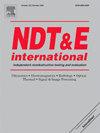An artefact suppression framework in ultrasonic phased array tomography for metal welds
IF 4.1
2区 材料科学
Q1 MATERIALS SCIENCE, CHARACTERIZATION & TESTING
引用次数: 0
Abstract
Artefacts that resemble defects can lead to inaccurate quality assessments in metal welds. Reducing residual artefacts while preserving the integrity of defect signals presents a significant challenge. To address this, a framework for artefact suppression based on a 3D denoising autoencoder is proposed, comprising two key developments: (1) The artefact rather than defects is reconstructed for the gradient vanishing issue in 3D denoising autoencoders when processing high-dimensional data, which results in excessive residual artefacts. Subsequently, a network framework based on multilayer bidirectional long short-term memory is proposed for tomographic image processing, enhancing reconstruction accuracy. (2) A cross-modal temporal-spatial attention module is developed to assist 3D autoencoders in identifying latent patterns of artefact. Particularly, their periodic differences are captured, regarded as the intrinsic distinction between defects and artefacts in tomographic detection. Experimental results demonstrate that the proposed framework effectively suppresses the side-lobe artefact and those caused by multiple reflections and mode conversions. While this approach is primarily designed for metal welds, it also shows promise for artefact suppression in metal castings and potential applications in medical imaging.
金属焊缝超声相控阵层析成像中的伪影抑制框架
类似缺陷的工件可能导致金属焊缝质量评估不准确。在保持缺陷信号完整性的同时减少残余伪影是一项重大挑战。为了解决这个问题,提出了一种基于三维去噪自编码器的伪影抑制框架,包括两个关键进展:(1)针对三维去噪自编码器在处理高维数据时梯度消失的问题,重构了伪影而不是缺陷,从而导致了过多的残余伪影。随后,提出了基于多层双向长短期记忆的层析图像处理网络框架,提高了重建精度。(2)开发了一个跨模态时空注意模块,帮助三维自编码器识别伪影的潜在模式。特别是,它们的周期性差异被捕获,被认为是断层扫描检测中缺陷和伪影之间的内在区别。实验结果表明,该框架有效地抑制了由多次反射和模式转换引起的副瓣伪影。虽然这种方法主要是为金属焊缝设计的,但它也显示出抑制金属铸件中的伪影和在医学成像中的潜在应用前景。
本文章由计算机程序翻译,如有差异,请以英文原文为准。
求助全文
约1分钟内获得全文
求助全文
来源期刊

Ndt & E International
工程技术-材料科学:表征与测试
CiteScore
7.20
自引率
9.50%
发文量
121
审稿时长
55 days
期刊介绍:
NDT&E international publishes peer-reviewed results of original research and development in all categories of the fields of nondestructive testing and evaluation including ultrasonics, electromagnetics, radiography, optical and thermal methods. In addition to traditional NDE topics, the emerging technology area of inspection of civil structures and materials is also emphasized. The journal publishes original papers on research and development of new inspection techniques and methods, as well as on novel and innovative applications of established methods. Papers on NDE sensors and their applications both for inspection and process control, as well as papers describing novel NDE systems for structural health monitoring and their performance in industrial settings are also considered. Other regular features include international news, new equipment and a calendar of forthcoming worldwide meetings. This journal is listed in Current Contents.
 求助内容:
求助内容: 应助结果提醒方式:
应助结果提醒方式:


